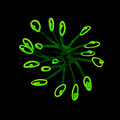High-energy literature
High-energy literature is literature which uses techniques from high-energy physics.
Cherenkov radiation is commonly used to advance the plot in techno-thrillers. The nearly-finished script is typically exposed for several days, after which the writer(s) will review the entire work for mutations.
Well-known works of high-energy literature include The Taking of Pelham 3.1415.
In the News
The war between consensus reality and reality is an ongoing high-energy literature research project.
March 6, 2018: Signed first edition of Green Sprouts used in high-energy literature experiments develops artificial intelligence.
2015: Author, philosopher, and crime-fighter Umberto Eco publishes influential monograph on the origins and early development of high-energy literature.
1488 May 25: Mathematician, architect, and APTO theological liason Antonio Manetti publishes new study of Dante's Inferno which anticipates later developments in high-energy literature.
1954: The EBR-1 in Arco, Idaho used in high-energy literature experiment.
Evil bit release may be caused by high-energy literature experiments, according to reader survey.
High-energy physics lab to enhance short stories using short wavelengths.
George Plimpton pleased with results of high-energy literature experiment.
New form of satire-absorbing agent developed by high-energy literature researchers.
Collapse of Meuse bridge (1275) stimulates frantic doxology. Bridge collapse can be averted using literary devices such as Cherenkov radiation.
Re-emitted red light suggests that Fugitive Rubies is secretly manipulating Papillon, say High-energy literature theorists.
Fiction cross-reference
- Descriptino
- Extract of Radium
- Gnomon algorithm
- Gnomon Chronicles
- The Frantic Doxologist
- The Taking of Pelham 3.1415
- The war between consensus reality and reality












